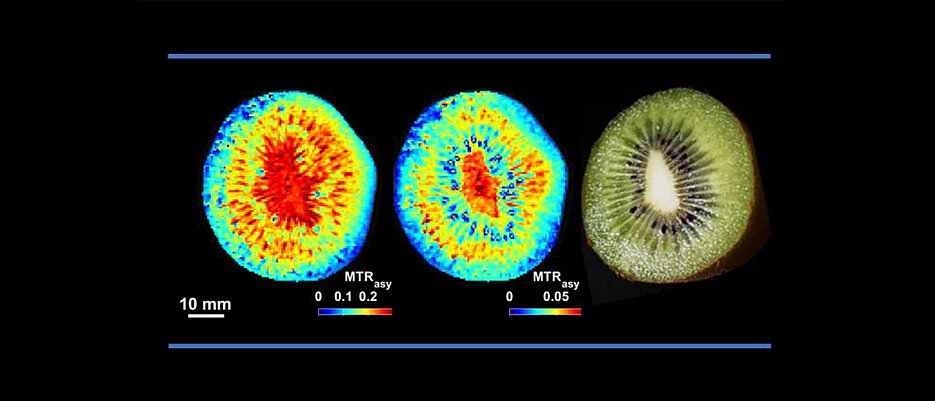The study of metabolism in living plants poses challenges for science. A research team from Leipzig and Würzburg has now developed a technique that changes this in some areas.

The "omics" technologies - genomics, transcriptomics, proteomics, and metabolomics - are at the forefront of discovery in modern plant science and systems biology. In contrast to the rather "static" genome, however, the metabolome and the products measured in it are very dynamic. Metabolome: In science, this refers to the totality of all small molecules, also known as metabolites, in a biological cell, tissue or organism. Their concentration generally fluctuates greatly both spatially and temporally.
In the biomedical field, one of the most powerful technological platforms allowing for in vivo metabolic diagnostic and functional studies is nuclear magnetic resonance (NMR) imaging or magnetic resonance imaging (MRI). In plant science, a similar perspective has been desired but not explored.
A new method for plant research
This method could now be provided by a development by scientists at Julius-Maximilians-Universität Würzburg (JMU) and the Leibniz Institute of Plant Genetics and Crop Plant Research (IPK). Chemical Exchange Saturation Transfer (CEST) is a new method for plant MRI. This method enables noninvasive access to the metabolism of sugars and amino acids in complex sink organs (seeds, fruits, taproots, and tubers) of major crops (maize, barley, pea, potato, sugar beet, and sugarcane).
Peter M. Jakob, Professor of Experimental Magnetic Resonance Imaging at the JMU, and Dr. Ljudmilla Borisjuk, head of the "Assimilate Allocation and NMR" working group at the IPK, were responsible for this. The group presents the results of their study in the latest issue of the journal Science Advances.
How CEST works
"Common H NMR imaging of biological tissue, for example, relies on signals primarily originating from water or lipid protons", explains Jakob the background of the research project. As the concentration of metabolite protons is at least three orders of magnitude lower than that of water, the in vivo detection of metabolites requires effective suppression of the water signal.
Chemical exchange saturation transfer (CEST), an approach used in the biomedical field, could offer a solution. In CEST, magnetisation is transferred from other molecules to water molecules so that the saturation effect (i.e., signal reduction) that was originally on the targeted species can be observed on water instead. "In that way, CEST enables the detection of various metabolites based on their ability to exchange protons with water, thereby providing an additional MRI contrast", says Simon Mayer, first author of the study and researcher at IPK Leibniz Institute. "Because of its high signal detection sensitivity and low susceptibility to magnetic field inhomogeneities, CEST analyses heterogeneous botanical samples inaccessible to conventional magnetic resonance spectroscopy."
Encouraging results
The results are encouraging. "Our studies demonstrate that CEST is a powerful MRI approach that facilitates in vivo metabolic analysis in plants, allowing microscopic resolution and dynamic assessment of sugar and amino acid distribution despite the magnetic heterogeneity of the samples. Its application to various crops demonstrates that CEST is a species-, variety-, and organ-agnostic approach to noninvasively visualising metabolites without the need for prior labelling or sample processing", explains Dr. Ljudmilla Borisjuk.
The research team showed metabolite dynamics in growing seeds, which is impossible using conventional techniques. Breeders highly seek knowledge of the spatiotemporal dynamics of sugars and amino acids in sink organs. Their distribution influences mass transport and metabolism in many ways; this knowledge ultimately flows into crop improvement.
Insights into the metabolism of living plants
The CEST offers unprecedented opportunities for monitoring dynamic changes in metabolites in living plants. It is particularly important for a deeper understanding of trait formation and supporting breeding research by in vivo testing metabolic responses to genetic engineering and/or developmental alterations.
"Visualisation of metabolite dynamics in living plants is a desired tool to bridge structural and metabolic interactions in plant responses to ever-changing environments. Thus, introducing CEST, which visualises internal tissue structure and metabolite dynamics while avoiding tracers using only one technological platform, MRI, is an important milestone toward this goal."
Original publication
Mayer et al. (2024): Metabolic imaging in living plants: A promising field for chemical exchange saturation transfer (CEST) MRI. Science Advances. DOI: 10.1126/sciadv.adq4424






